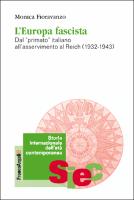L’Europa fascista
Dal “primato” italiano all’asservimento al Reich (1932-1943)
| dc.contributor.author | Fioravanzo, Monica | |
| dc.date.accessioned | 2022-03-28T15:31:46Z | |
| dc.date.available | 2022-03-28T15:31:46Z | |
| dc.date.issued | 2022 | |
| dc.identifier | ONIX_20220328_9788835134671_7 | |
| dc.identifier | OCN: 1313552309 | |
| dc.identifier.uri | https://library.oapen.org/handle/20.500.12657/53626 | |
| dc.language | Italian | |
| dc.relation.ispartofseries | Storia internazionale dell’età contemporanea | |
| dc.subject.classification | thema EDItEUR::J Society and Social Sciences::JP Politics and government::JPF Political ideologies and movements::JPFQ Far-right political ideologies and movements | en_US |
| dc.subject.classification | thema EDItEUR::N History and Archaeology::NH History::NHW Military history::NHWR Specific wars and campaigns::NHWR7 Second World War | en_US |
| dc.subject.classification | thema EDItEUR::N History and Archaeology::NH History::NHW Military history::NHWL Modern warfare | en_US |
| dc.subject.classification | thema EDItEUR::3 Time period qualifiers::3M c 1500 onwards to present day::3MP 20th century, c 1900 to c 1999::3MPB Early 20th century c 1900 to c 1950::3MPBL c 1940 to c 1949::3MPBLB c 1938 to c 1946 (World War Two period) | en_US |
| dc.subject.classification | thema EDItEUR::N History and Archaeology | en_US |
| dc.subject.classification | thema EDItEUR::3 Time period qualifiers::3M c 1500 onwards to present day::3MP 20th century, c 1900 to c 1999 | en_US |
| dc.subject.other | new european order, Italian Fascism, The Axis, the thirties, the crisis of Europe, fascist europe, second world war, Third Reich, debate on the new Europe, new economic order, eurafrica, eurafrasia | |
| dc.title | L’Europa fascista | |
| dc.title.alternative | Dal “primato” italiano all’asservimento al Reich (1932-1943) | |
| dc.type | book | |
| oapen.abstract.otherlanguage | The European Axis policy remains largely unwritten. Little is known about the factors that united or divided the Fascist regime and the Nazi Reich regarding the post-war order. Furthermore, even less is known about the Italian plans for a fascist Europe, which wartime events soon relegated to the margins of Axis policy. This book reconstructs the debate on the new European order developed from the 1930s to the spring of 1943 by Fascist politicians, philosophers, writers, anthropologists, and geographers. The debate progressed alongside the evolution of the international framework and in parallel with the war. The diachronic examination of these projects, where distinctive elements of Fascist ideology were instrumentally entwined with Latin and Catholic tradition, allows us to recover the thread of relations between Italy and Germany and between Italy and the minor allies of the Axis. The very choice of words - Fascist Europe, Axis Europe, Catholic Europe or Europe of Nations - reflects a shift in the balance of power: from collaboration to competition, from fear to an attempt to regain prominence. In 1943, the idea of a Europe of nations with an explicitly anti-German intent was the final, unrealistic assertion toward a new order where Axis Europe was not just Nazi Europe. | |
| oapen.relation.isPublishedBy | e2ddfb5e-9202-4851-8afe-1e09b020b018 | |
| oapen.relation.isbn | 9788835134671 | |
| oapen.pages | 206 | |
| oapen.place.publication | Milan |

